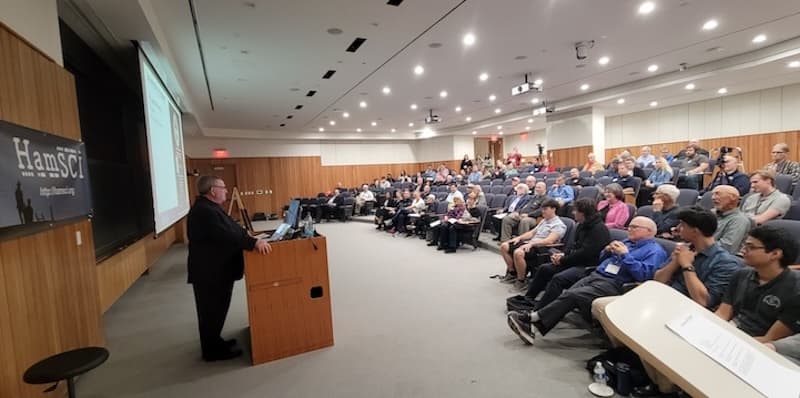Teaching Teeming at W3USR Ham Radio Station

Vibrant views of Jesuit education already occurring at The University of Scranton’s state-of-the-art amateur radio station were celebrated at the formal dedication of the facility located on the fifth floor of the Loyola Science Center.
University of Scranton President, Rev. Joseph Marina, S.J., referenced the teaching, research and engagement with students and the greater community already taking place at the station in his remarks at the ceremony.
“Dr. Frissell and his colleagues in the Physics and Engineering Department have sparked the curiosity of students – starting a student amateur radio club (W3USR), leveraging the station’s capacities in courses, and involving students in research projects,” said Father Marina, who also blessed the station at the ceremony. “True to a Jesuit education, the station’s resources have turned outward in service to others – whether inviting Cub Scouts in to encourage interest in science or leveraging the station’s capabilities for the emergency communication needs of area agencies.”
Father Marina also mentioned the numerous research projects led by Nathaniel Frissell, Ph.D., associate professor of physics and engineering at the University, and his colleagues in the Physics and Engineering Department.
“The research has supported projects with NASA with students sharing their discoveries in presentations at national conferences. Research has involved partnerships with other colleges, such as Case Western, the New Jersey Institute of Technology and the University of Alabama,” said Father Marina.
At the dedication, Dr. Frissell (W2NAF) provided an overview of the station’s state-of-the-art antennas and communication equipment, as well as some of the research projects that have leveraged the station’s capacities, including the Ham Radio Science Citizen Investigation (HamSCI) network he developed through projects supported by National Science Foundation grants, including the University’s participation in NASA’s Citizen Science Investigations that studied the effects of the recent total solar eclipse on the earth’s ionosphere. Dr. Frissell also acknowledged the generous grant the station received from the Amateur Radio Digital Communications (ARDC) foundation, with additional support from Mary Lou West, Ph.D., (KC2NMC), Edward Hayes (N6XEM), Jeffrey DePolo (WN3A), DXEngineering, and the NSF.
Speaking at the dedication were University of Scranton student Alexandros Papadopoulos, (KC3WUD) Scotrun, a computer engineering major at Scranton, and Steve Cerwin, (WA5FRF) a community volunteer and retired scientist at Southwest Research Institute, who discussed research projects they have conducted using data gathered from these projects.
The dedication included a presentation by Bob Inderbitzen, (NQ1R) director of marketing and innovation for the National Association for Amateur Radio (ARRL), who granted W3USR Student Amateur Club ARRL Affiliated Club status. Since its inception in 1918, the Affiliated Club Program has united amateur radio clubs to enhance the Amateur Radio Service, recognizing their crucial role in developing active radio operators and serving local communities. The formal presentation of a certificate of membership was made to University student and W3USR Student Amateur Club president Gerard Piccini, (KD2ZHK) Monroe Township, New Jersey, who is majoring in electrical engineering at Scranton.
“You are now part of a thriving network of college ham radio stations across the country, each contributing to a larger tapestry of knowledge, innovation, and fun,” said Inderbitzen, who also serves as staff advisor the ARRL Collegiate Amateur Radio Program
Also speaking at the ceremony were Rosy Schechter, KJ7RYV, executive director of ARDC and Shikha Raizada, Ph.D., (WP4PYE) NSF aeronomy program director; and Tracy Stewart, Ph.D., interim provost and senior vice president for academic affairs at The University of Scranton.
Immediately following the ceremony, students presented posters of their research projects and tours of the radio station were conducted.
Located on the fifth floor (penthouse suite) of the Loyola Science Center, the main station has floor to ceiling glass walls with sweeping views of the city of Scranton. Last academic year, a 40-foot tower with a Skyhawk High Frequency antenna for 14, 21, and 28 MHz, as well as VHF/UHF satellite and microwave antennas, some with rotating mounts were installed, in addition to heavy-duty controllers, all-mode transceivers, speakers, desktop microphones and other components.
A dinner reception concluded the dedication events.
WVIA news reporter Sarah Hofius Hall spoke to Dr. Frissell about the amateur radio station at a recent community session. The station is open to members of the general public Thursday evenings from 7 p.m. to 9 p.m. during the spring and fall semesters.































